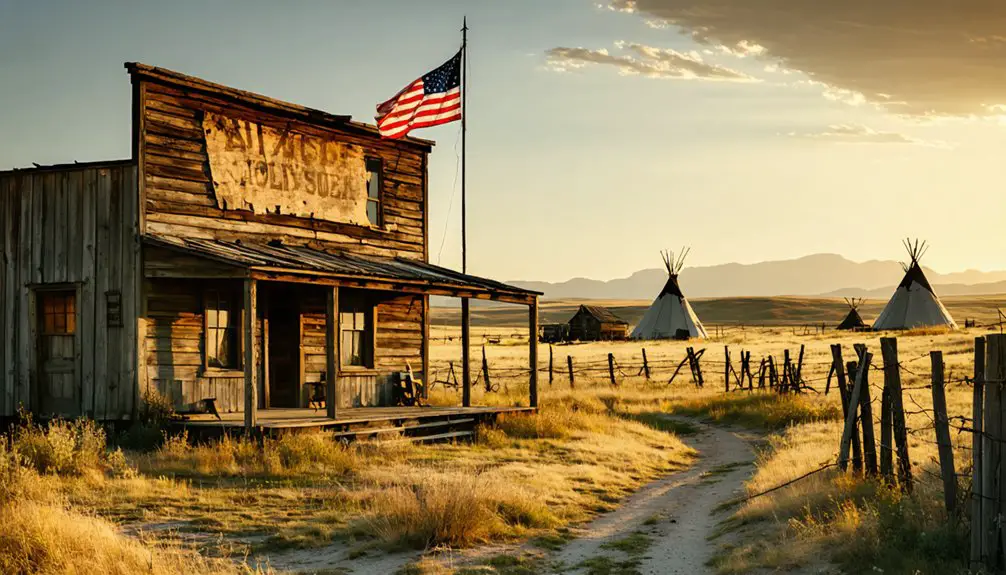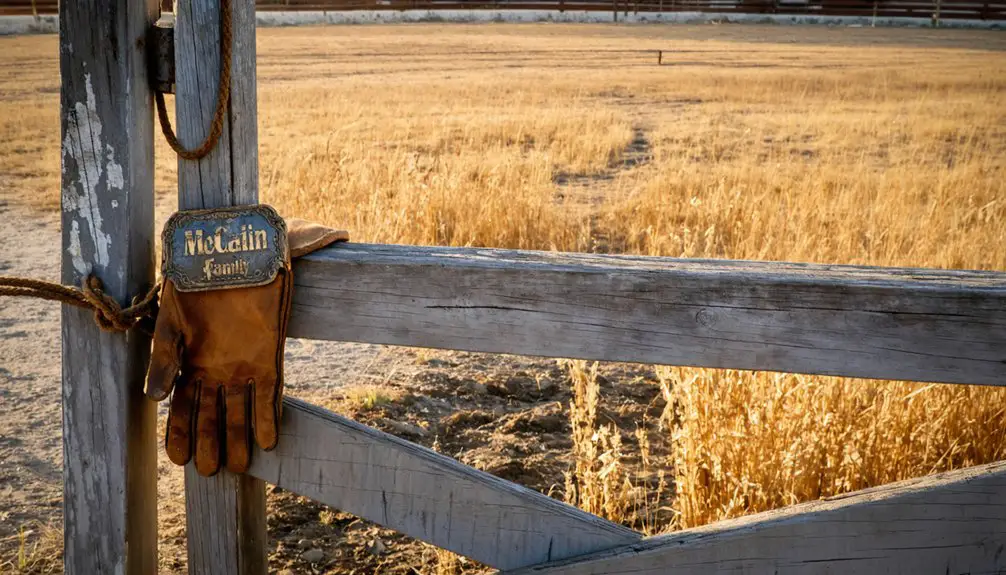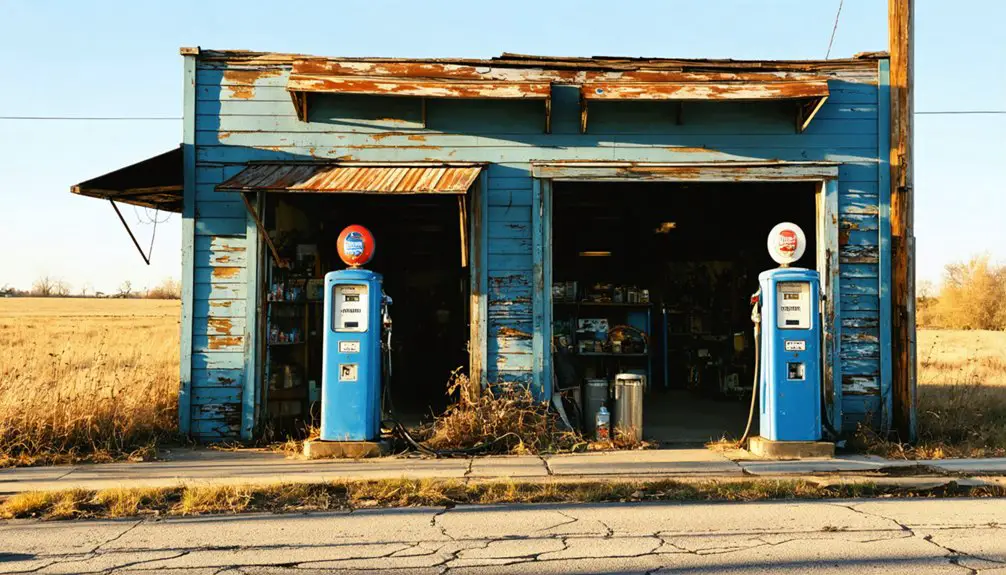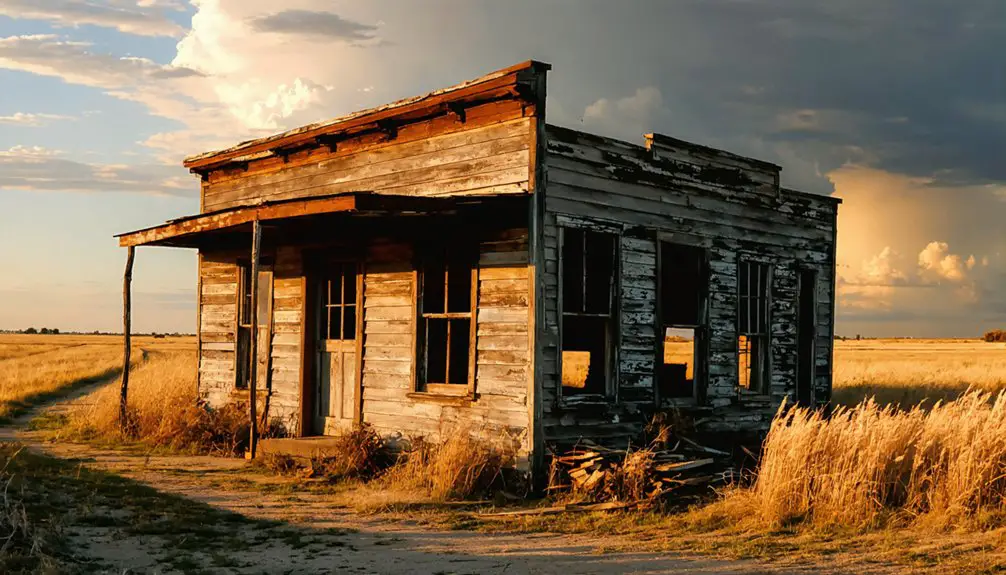You’ll find Sun City, Kansas tucked away in Barber County, where this once-thriving frontier town has dwindled to just 34 residents today. In its 1930s heyday, over 10,000 people called Sun City home, drawn by buffalo trading, agriculture, and the famous McLain Rodeo that rivaled Buffalo Bill’s Wild West Show. While the grain elevator still stands as a monument to its prosperous past, the rerouting of major transportation routes left this prairie community largely frozen in time.
Key Takeaways
- Sun City’s population has drastically declined from over 10,000 residents in 1930 to just 34 residents today, with a median age of 68.4.
- Once a thriving buffalo trading post and rodeo destination, the town’s isolation from modern transportation routes led to its economic decline.
- The McLain Rodeo (1922-1938) marked Sun City’s last major period of prosperity before its gradual transformation into a ghost town.
- The town’s original prosperity came from buffalo hide trading, with hides selling for up to $1.25 during the 1870s economic boom.
- A single grain elevator remains as testament to Sun City’s former agricultural significance and shipping capabilities.
Early Frontier Settlement and Pioneer Life
As white settlers began pushing into Barber County in the early 1870s, Griffin established the area’s first ranch along a branch of the Medicine Lodge River, about a mile from what would become Sun City.
Sadly, Griffin’s pioneering spirit was cut short when he was killed in Indian Territory the following summer, but his legacy lives on as the county’s first white settler.
Griffin’s tragic death in Indian Territory ended his frontier dreams, yet he remains remembered as the pioneering first settler of the county.
The settlement struggles were intense for those who followed.
You’d find early residents living in dugout homes, facing constant threats from local Indians who opposed their presence.
Pioneer hardships included failed farming attempts and deadly raids that decimated livestock.
Despite these challenges, Civil War veterans and other settlers persisted, with some turning to buffalo hunting and cattle raising to survive.
Solomon Tuttle’s introduction of Texas cattle in 1872 proved particularly significant, taking advantage of the area’s rich grasslands.
primitive stockades during spring 1874 to protect themselves from ongoing Indian attacks.
A local militia was organized that same year to defend against the persistent Indian raids.
Rise of Buffalo Trading and Commerce
In 1874, you’d find Sun City’s first trading post serving buffalo hunters and Native Americans about four miles northwest of the current town site, where George Walker and his partners had already established a dugout trading post near Turkey Creek three years prior.
The buffalo hide business boomed as hunters could get between 50 cents to $1.25 per hide, attracting numerous commercial ventures that transformed the frontier economy. The industry was dominated by merchants like Charles Rath, who managed over a million buffalo hides through his trading operations. Local settlers constructed two stockades for protection during this period of rapid commercial growth.
Trading Post Operations
The bustling Sun City Trading Post, founded by buffalo hunter Col. Griffin in 1871, began as a humble dugout shelter on Turkey Creek’s east bank.
You’d find the trading post’s evolution remarkable – from a basic outpost supplying buffalo hunter supplies to a thriving commercial hub serving both Native Americans and frontier settlers. Similar to Cyprian Chouteau’s post established in 1825, it played a vital role in regional commerce and cultural exchange. The Osage and Miami tribes were frequent traders at such outposts, establishing vital economic relationships with settlers.
Buffalo Hide Market Impact
Buffalo hide trading transformed Sun City from a modest outpost into a powerhouse of commerce during the 1870s.
You’d find hide yards stretching 175 feet long, packed with up to 80,000 buffalo hides waiting for shipment to Pennsylvania tanneries. The economic ramifications rippled through the region as hunters earned between 50 cents to $1.25 per hide. For each hunter, there were two to five workers who skinned, hauled, and transported the hides.
The buffalo hide trade brought a wave of entrepreneurs and adventurers, including famous figures like Cody and Earp, who’d later shape the American West. Professional hunters carried minimal equipment including blankets, water kegs, and basic cooking tools.
Supply stores, blacksmith shops, and protective stockades sprang up to support the booming industry. While the trade brought prosperity, it also sparked conflicts with Native American tribes who watched their primary resource vanish.
Sun City’s growth mirrored the rise and fall of this lucrative but ultimately unsustainable commerce.
Early Commercial Ventures
While Col. Griffin established the first ranch near Sun City in 1871-72, it was E.H. Mosley’s trading post that sparked the area’s commercial growth.
You’ll find trading post dynamics centered around buffalo hide collection and trading with Native Americans, creating essential hubs for hunters and settlers alike.
The region’s commercial infrastructure expanded dramatically when Jacob Achenbach purchased 6,300 acres in 1884.
The abundant presence of rich sandstone deposits in the northwestern area near Sun City helped support local construction efforts.
By 1885, you’d have discovered a bustling town with two hotels, multiple livery barns, dry goods stores, groceries, and even The Merchants’ and Drovers’ Bank.
The town’s establishment of a post office in 1886, with Achenbach as postmaster, cemented its position as a commercial center.
While farming ventures struggled in the harsh environment, trading and livestock-related businesses thrived, shaping Sun City’s early economic identity.
During the summer of 1874, the town built protective stockades to defend against ongoing Indian raids in the area.
Conflict and Defense on the Prairie
Living on Kansas’s harsh frontier required constant vigilance, as Sun City’s early settlers faced threats from multiple directions during the 1870s.
The first pioneer conflicts emerged when E.H. Mosley, Lockwood, and Leonard’s farming activities angered local Native Americans, leading to deadly raids. You’d have found settlement defenses throughout the town, including stockades running through Main Street’s alleys.
After Mosley’s death during one attack, surviving settlers retreated behind these protective barriers while raiders destroyed their livestock. The U.S. Army later built additional stockades to both protect settlers and detain unruly Native Americans.
Native American Relations and Challenges

Long before Sun City’s establishment, complex Native American relations shaped Kansas’s territorial development through successive waves of tribal displacement. You would’ve found at least 19 reservations across eastern Kansas by 1846, including relocated Shawnee and Cherokee tribes.
Tribal negotiations at Medicine Lodge Creek in 1867 attempted to establish peaceful boundaries, though cultural resistance remained strong.
Native leaders took differing approaches to these changes. Some, like Shawnee Chief Charles Tucker, adapted to farming and settler ways. Others, like Chief Black Bob, firmly rejected assimilation.
The region’s original inhabitants – the Kanza, Osage, Pawnee, and Comanche – faced continuous pressure as treaties and relocations reshaped their ancestral lands, ultimately leading to their forced removal to Indian Territory.
Economic Growth and Golden Years
You’d find Sun City’s 1880s business district bustling with activity, featuring general stores, a pharmacy, and various merchants serving the growing population.
The McLain family’s rodeo operation brought significant economic benefits to the area, drawing visitors from across the region and providing seasonal employment opportunities.
Local newspaper accounts from the period indicate the rodeo events generated substantial revenue for hotels, restaurants, and other businesses in town.
Thriving 1880s Business District
The bustling business district of Sun City reached its zenith during the 1880s, transforming from a frontier settlement into a robust commercial hub.
You’d have found remarkable business diversity along its streets, with two hotels welcoming travelers, three livery barns serving the cattle trade, and multiple retail establishments meeting residents’ needs.
The town’s economic backbone included two dry goods stores, three groceries, a hardware store, and even a shoe shop.
The Sun State Bank anchored the district’s financial operations, demonstrating the community’s resilience and economic maturity.
This thriving marketplace served both local ranchers and farmers, who’d brought in Texas cattle and high-grade livestock to stock the expanding range.
The business district perfectly balanced retail, services, and banking – everything you’d need in a growing frontier town.
McLain Rodeo’s Economic Impact
During the 1920s and 1930s, Sun City’s business district experienced another wave of prosperity thanks to the McLain Rodeo Roundup, which grew into one of the world’s largest rodeos.
The rodeo economics transformed the town, drawing massive crowds that filled local hotels, saloons, and livery stables. You’d find the streets bustling with visitors who’d traveled far to witness the spectacular events on the 25-acre arena.
Community engagement soared as the roundup hosted diverse attractions including daily races, carnivals, dances, and Native American exhibitions.
The event rivaled Buffalo Bill’s Show in reputation, attracting top cowboys and members of the Cowboys Turtle Association. Local businesses thrived from the seasonal surge, while the town’s investment in infrastructure and hospitality services helped cement Sun City’s status as a premier entertainment destination.
McLain Rodeo Legacy and Western Culture

As Sun City’s cultural cornerstone from 1922 to 1938, Mac McLain’s legendary rodeo roundup grew into one of the world’s largest western spectacles, rivaling even Buffalo Bill’s Wild West Show in fame and attendance.
You’ll find deep rodeo traditions woven into the fabric of this prairie town, where cowboy culture thrived across 25 acres of arena space and a mile-long racetrack.
- Chuck wagon races and daily horse competitions showcased authentic frontier skills
- Cowboys, Native Americans, and locals united in festivities, dances, and carnival celebrations
- The Medicine Lodge Peace Treaty Association honors this legacy today through the Gyp Hills Roundup Rodeo
Though Sun City’s now a ghost town, McLain’s rodeo spirit lives on through historic landmarks and modern events that keep these cherished western traditions alive.
Transportation Routes and Regional Connections
While railroads once breathed life into Sun City’s commerce in the early 1900s, subsequent rerouting of major transportation corridors sealed the town’s fate.
The town’s transportation history shows how shifting rail lines and highways gradually isolated this once-bustling community from essential trade routes.
You’ll find evidence of Sun City’s former importance in regional trade through its remaining grain elevator, which stands as a reflection of its agricultural past.
The town originally thrived on shipping wheat, corn, and gypsum from nearby mines to larger processing centers like Medicine Lodge.
Col. Griffin’s trading posts connected local ranching communities, while rodeos drew visitors from across the region.
Today, though most transport routes bypass Sun City entirely, some connections persist primarily to serve the area’s remaining agricultural and mining operations.
Population Changes Through Time

Since establishing its first white settlement in 1871, Sun City’s population has traced a dramatic arc from frontier boom to near abandonment. The population dynamics tell a story of rapid growth, with Barber County surging from 2,661 residents in 1880 to 7,973 by 1890.
You’ll find dramatic demographic shifts throughout the town’s history:
- Peak prosperity came in 1930 when the county reached 10,178 residents, driven by farming and buffalo hunting.
- The 1970s marked a turning point with a sharp 19.5% population decline as residents sought urban opportunities.
- Today’s Sun City counts just 34 residents with a median age of 68.4 years, reflecting the broader exodus from rural Kansas.
These changes transformed Sun City from a bustling frontier settlement into what’s fundamentally becoming a ghost town.
Present-Day Heritage and Tourism
Despite its dwindling population, Sun City’s rich heritage continues to draw history enthusiasts and outdoor adventurers to this remote Kansas settlement.
You’ll discover preserved historic buildings from 1874, including an old stockade and mill, while the former High School now serves as an essential Community Center.
Heritage preservation efforts showcase the town’s prominence during the McLain Rodeo era through interpretive markers and seasonal events at Buster’s Saloon.
Tourism development focuses on integrating natural and cultural attractions.
You can explore the surrounding Gypsum Hills on scenic drives, hunt local wildlife, or join regional ghost town tours.
While Sun City lacks a dedicated visitor center, self-guided tours and historical markers help you navigate the town’s significant sites.
The nearby Gypsum Mine operations connect visitors to the area’s enduring industrial heritage.
Frequently Asked Questions
What Happened to E.H. Mosley’s Trading Post After His Death?
You’ll find Mosley’s legacy faded quickly as his trading post ceased operations after his 1872 death in an Indian raid. Eli Smith briefly occupied the site, but new stores in Kiowa soon replaced it.
How Many Students Attended Sun City’s High School at Its Peak?
Imagine walking through hallways that held between 30-100 students at Sun City’s peak enrollment. Historical records and local demographics suggest you’d have seen graduating classes of 5-15 students each year.
What Was the Average Property Value in Sun City During 1880S?
You won’t find specific property values from the 1880s, as economic factors and property trends weren’t well documented. Rural Kansas land typically sold for $1-$5 per acre during this period.
Which Native American Tribes Were Specifically Held in the Sun City Stockade?
You won’t find records of the Cheyenne, Arapaho, or any other tribes being held in the Sun City stockade – it served solely as a defensive structure for protecting settlers against raids.
Did Any Famous Outlaws Ever Pass Through or Hide in Sun City?
While you’ll find no direct proof of famous outlaws hiding in Sun City, Henry Newton Brown and his gang, including Ben Wheeler, likely passed through given their documented criminal activities in nearby Medicine Lodge.
References
- http://kansasghosttowns.blogspot.com/2010/12/dashed-hopes-to-be-reno-seat-part-of.html
- https://legendsofkansas.com/barber-county-kansas/
- https://legendsofkansas.com/kansas-ghost-town-list/
- https://www.kancoll.org/books/cutler/barber/barber-co-p1.html
- https://www.travelks.com/places-to-visit/cities/sun-city/
- https://fhsuguides.fhsu.edu/kansasheritage/barbercounty
- https://www.ksgenweb.org/KSBarber/earlyhist.htm
- https://fordcountyhistory.org/the-rath-trail/chapter-10-the-buffalo-trade/
- https://www.ksgenweb.org/KSBarber/towns/suncity.html
- https://www.historynet.com/skin-bones-plains-buffalo-trades-flourished/



